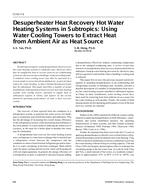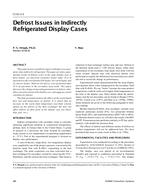-
-
Available Formats
- Options
- Availability
- Priced From ( in USD )
-
Available Formats
-
- Immediate download
- $16.00
- Add to Cart
Customers Who Bought This Also Bought
-

CI-01-08-3 -- Whole-Building Airflow Network Characteriza...
Priced From $16.00 -

CI-01-07-3 -- Desuperheater Heat Recovery Hot Water Heati...
Priced From $16.00 -

CI-01-02-3 -- Defrost Issues in Indirectly Refrigerated D...
Priced From $16.00 -

CI-01-09-3 -- The Role of the National Institute of Stand...
Priced From $16.00
About This Item
Full Description
Standard meteorological data for use by HVAC engineers commonly overestimate zero and low wind speed occurrences due to the use of the robust, rotating cup anemometers. These data will, therefore, significantly underestimate wind-driven natural ventilation and also pollution dispersal (of interest in health and safety respects). Measurements presented in this paper, taken with a standard meteorological rotating cup anemometer (as used by the U.K. Met Office) alongside an ultrasonic anemometer, show that due to inertia and friction, the rotating cup anemometer can indicate zero wind speed over many hours in a day when, in fact, speeds of up to 1.5 m/s (4.9 ft/s) can be present. The rotating cup anemometer is shown to be increasingly inaccurate as the wind speed drops below 3 m/s (9.8 ft/s). The paper describes how more accurate low wind data can be extracted from rotating cup measurements using a weibull nonlinear least squares fit to higher speed data. Figure 1 Ventilation funnels or chimneys at the DeMontfort Queen's building (CIBSE 1997; Bunn 1993).
Units: Dual





